Westland Lynx
The Westland Lynx is a British multi-purpose military helicopter designed and built by Westland Helicopters at its factory in Yeovil. Originally intended as a utility craft for both civil and naval usage, military interest led to the development of both battlefield and naval variants. The Lynx went into operational usage in 1977 and was later adopted by the armed forces of over a dozen nations, primarily serving in the battlefield utility, anti-armour, search and rescue and anti-submarine warfare roles.
The Lynx was the world's first fully aerobatic helicopter. In 1986 a specially modified Lynx set the current Fédération Aéronautique Internationale's official airspeed record for helicopters.[1] The Westland 30 was derived from the Lynx as a civil utility helicopter, however it was not a commercial success and only a limited number were built. In the 21st century, a modernised military variant of the Lynx, designated as the AgustaWestland AW159 Wildcat, as multirole combat helicopter scheduled to enter service in 2014. The Lynx remains in production under AgustaWestland, the successor to Westland Helicopters.
Development
Origins
The initial design (then known as the Westland WG.13) was started in the mid-1960s as a replacement for the Westland Scout and Wasp, and a more advanced alternative to the UH-1 Iroquois.[2] As part of the Anglo-French helicopter agreement signed in February 1967, the French company Aérospatiale were given a work share in the manufacturing programme.[3] Aérospatiale received 30% of production with Westland performing the remainder.[4] It was intended that France would buy Lynxes for its Navy and as an armed reconnaissance helicopter for the French Army, with the United Kingdom in return buying Aérospatiale Gazelles and Pumas for its armed forces. The French Army cancelled its requirement for Lynxes in October 1969.[3]
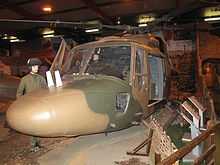
The original Lynx design was powered by two Rolls-Royce Gem 2 turboshaft engines, and used many components derived from the Scout and Wasp. However, the rotor was new, being of a semi-rigid design with honeycomb sandwich blades.[5][6] The first Lynx prototype took its maiden flight on 21 March 1971.[4][7] In 1972, a Lynx broke the world speed record over 15 and 25 km by flying at 321.74 km/h (199.9 mph). It also set a new 100 km closed circuit record shortly afterwards, flying at 318.504 km/h (197.9 mph).[8]
The British Army ordered over 100 Lynxes, designated the Lynx AH.1 (Army Helicopter Mark 1), for different roles, such as transport, armed escort, anti-tank warfare (with eight TOW missiles), reconnaissance and evacuation. The Army has fitted a Marconi Elliot AFCS system onto the Lynx for automatic stabilisation on three axes.[5] Deliveries of production Lynxes began in 1977.[4] An improved Lynx AH.1 with Gem 41-1 or Gem 42 engines and an uprated transmission was referred to as the Lynx AH.5; only five were built for evaluation purposes. The AH.5 led to the Lynx AH.7, which added a new tail rotor derived from the Westland 30, a reinforced airframe, improved avionics and defensive aids. These later received upgrades such as British Experimental Rotor Programme (BERP) rotor blades.[9]
The initial naval variant of the Lynx, known as the Lynx HAS.2 in British service, or Lynx Mk.2(FN) in French service,[citation needed] differed from the Lynx AH.1 in being equipped with a tricycle undercarriage and a deck restraint system, folding main rotor blades, an emergency flotation system and a nose-mounted radar. An improved Lynx for the Royal Navy, the Lynx HAS.3, had Gem 42-1 Mark 204 engines, an uprated transmission, a new flotation system and an Orange Crop ESM system. The Lynx HAS.3 also received various other updates in service. A similar upgrade to the French Lynx was known as the Lynx Mk.4(FN). Many different export variants based on the Lynx HAS.2 and HAS.3 were sold to other air arms.[9]
In 1986, the former company demonstrator Lynx, registered G-LYNX, was specially modified with Gem 60 engines and BERP rotor blades.[10] On 11 August 1986 the helicopter was piloted by Trevor Egginton when it set an absolute speed record for helicopters over a 15 and 25 km course by reaching 400.87 km/h (249.09 mph);[1] an official record with the FAI it currently holds.[1][11]

Super Lynx and Battlefield Lynx
Announced in 1984, the Lynx-3 was an enhanced Lynx development, with a stretched fuselage, a redesigned tailboom and tail surfaces, Gem 60-3/1 engines and a new wheeled tricycle undercarriage.[9] The Lynx-3 also included BERP rotor blades, and increased fuel capacity.[12] Both Army and Naval variants were proposed.[5] The project was ended in 1987 due to insufficient orders.[12] Only one Army Lynx-3 prototype was built.[9]
A development of the Lynx AH.7 with the wheeled undercarriage of the Lynx-3 was marketed by Westland as the Battlefield Lynx in the late 1980s.[9] The prototype first flew in November 1989 and deliveries began in 1991.[13] This variant entered British Army service as the Lynx AH.9.[9]
In the early 1990s, Westland incorporated some of the technology from the Naval Lynx-3 design into a less-radical Super Lynx. This featured BERP rotor blades, the Westland 30-derived tail rotor, Gem 42 engines, a new under-nose 360-degree radar installation and an optional nose-mounted electro-optical sensor turret. Royal Navy Lynx HAS.3s upgraded to Super Lynx standard were known in service as the Lynx HMA.8, and several export customers ordered new-build or upgraded Super Lynxes. Later, Westland offered the Super Lynx 200 with LHTEC CTS800 engines and the Super Lynx 300, which also had a new cockpit and avionics derived from the AgustaWestland EH101. Both of these models have achieved several export sales.[9]
Future Lynx/Lynx Wildcat
The British Army and Royal Navy Lynx fleets are due to be upgraded to a new common advanced Lynx variant based on the Super Lynx 300, with a new tailboom, undercarriage, cockpit, avionics and sensors.[9] Initially referred to as the Future Lynx, then Lynx Wildcat, this type has since been renamed as the AW159 Wildcat.
Design
The Lynx is a multi-purpose helicopter design with a side by side cockpit for pilot and observer. It features a large sliding crew door on each side giving access to the cabin which can be used to accommodate up to nine equipped troops dependent on seating configuration, or alternatively radio equipment when used in the command post role or surplus fuel for long journeys.[9] Its twin Rolls-Royce Gem turboshaft engines power a four-blade semi-rigid main rotor system.[9][14] The Lynx is an agile helicopter, capable of performing loops and rolls.
Operational history


The Lynx Mk.2(FN) entered service with the French Navy's Aviation navale in 1979. The Lynx AH.1 entered service with the Army Air Corps (AAC) in 1979, followed by the Lynx HAS.2 with the Fleet Air Arm (FAA) in 1981. The FAA Lynx fleet was upgraded to Lynx HAS.3 standard during the 1980s, and again to Lynx HMA.8 standard in the 1990s. Most Army Lynx were later upgraded to Lynx AH.7 standard.[9]
As of 2009, the AAC operate the Lynx AH.7 and AH.9 as utility helicopters. Army owned Lynx AH.7 and AH.9 are also in service with the FAA where they operate as attack/utility helicopters in support of the Royal Marines. Lynx HAS.3 and HMA.8 operate as anti-submarine warfare and maritime attack helicopters equipped with the Stingray torpedo, Sea Skua anti-ship missile and depth charges from Royal Navy warships. HAS.3 and HMA.8 are also capable of anti-trafficking and anti-piracy roles when carrying boarding parties and when fitted with the FN Herstal M3M pintle mounted heavy machine gun.
The HAS.2 naval ASW variant took part in combat operations in British service during the Falklands War in 1982. Although none were shot down, three were lost aboard vessels hit in Argentine air attacks (HMS Coventry, HMS Ardent and MV Atlantic Conveyor).[15]
Lynx helicopters used the Sea Skua to devastating effect against the Iraqi Navy during the 1991 Gulf War. The Lynx also saw service with British Army forces during that conflict.
In September 2000 the Lynx was used during an operation to rescue British soldiers in Sierra Leone.
The Lynx was used during the invasion of Iraq in 2003. It has also seen extensive service during peacekeeping operations and exercises, and it is standard equipment for most Royal Navy surface combatants when they deploy.
A British Lynx from 847 Naval Air Squadron was shot down over Basra, Iraq on 6 May 2006. The helicopter was downed by a surface-to-air missile (using a Man Portable Air Defence System) killing all five on board. This was the first British helicopter and only the second British aircraft downed (the first was an RAF Hercules) due to enemy fire in the war. A flight of either AAC or RM Lynx AH.7s were based at Basra Air Station under command of the Joint Helicopter Force (Iraq) on a rotational basis,[16] but are restricted operationally during the summer months due to the very high daytime temperatures which affect lifting capacity and endurance dramatically.
The Super Lynx has been used extensively by the Portuguese Navy in Operation Ocean Shield. It operates from NRP Alvares Cabral and has been fitted with a FN M3M 12.7 mm machine gun.
On 28 February 2011, one Royal Netherlands Navy Naval Aviation Service Lynx was captured in Libya during an evacuation mission. Three navy personnel were taken prisoner by Libyan troops and two civilians were evacuated by other means.[17]
Variants
Land-based variants

- Westland WG.13
- Prototype, first flight 21 March 1971. Thirteen prototypes built.[18]
- Lynx AH.1
- Initial production version for the British Army Air Corps, powered by 671 kW (900 hp) Gem 2 engines,[19] with first production example flying 11 February 1977, and deliveries continuing until February 1984, with 113 built.[20] Used for a variety of tasks, including tactical transport, armed escort, anti-tank warfare (60 were equipped with eight TOW missiles as Lynx AH.1 (TOW) from 1981),[21] reconnaissance and casualty evacuation.[22]
- Lynx AH.1GT
- Interim conversion of the AH.1 to partial AH.7 standard for the Army Air Corps with uprated engines and revised tail rotor.[23]
- Lynx HT.1
- Planned training version for Royal Air Force. Cancelled.[23]
- Lynx AH.5
- Upgraded version for the Army Air Corps, with 835 kW (1,120 shp) Gem 41-1 engines and uprated gearbox.[24] Three built as AH.5 (Interim) as Trials aircraft for MoD. Eight ordered as AH.5s for Army Air Corps, of which only two built as AH.5s, with remaining six completed as AH.7s.[25] Four were later upgraded to AH.7 standard and one was retained for trials work as an AH.5X.
- Lynx AH.6
- Proposed version for the Royal Marines with undercarriage, folding tail and deck harpoon of Naval Lynx. Not built.[25]
- Lynx AH.7
- Further upgraded version for the Army Air Corps, with Gem 41-1 engines and uprated gearbox of AH.5 and new, larger, composite tail rotor. Later refitted with BERP type rotor blades. Twelve new build, with 107 Lynx AH.1s converted.[26] A small number also used by the Fleet Air Arm in support of the Royal Marines.[27] Now replaced by the WAH-64 Apache as the main attack helicopter.
- Lynx AH.7(DAS)
- AH.7 with Defensive Aids Subsystem.
- Lynx AH.9 ("Battlefield Lynx")
- Utility version for Army Air Corps, based on AH.7, but with wheeled undercarriage and further upgraded gearbox. Sixteen new-built plus eight converted from AH.7s.[28]
Naval variants
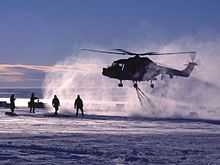

- Lynx HAS.2 / Mk.2(FN)
- Initial production version for the Royal Navy (HAS.2) and the French Navy (Mk.2(FN)), powered by Gem 2 engines and with wheeled undercarriage, folding rotors and tail and deck harpoon. HAS.2 equipped with British Sea Spray radar, with Mk.2(FN) having French radar and dipping sonar. When it is used in the anti-submarine role, it can carry two torpedoes or depth charges. For anti-surface warfare, it is equipped with either four Sea Skua missiles (Royal Navy) or four AS.12 missiles (French Navy).[31] 60 built for Royal Navy,[32] and 26 for France.[33]
- Lynx HAS.3
- Improved version of HAS.2 powered by Gem 42-1 engines and with upgraded gearbox. Thirty built from new, with deliveries starting in March 1982 and all remaining HAS.2s (53 aircraft) converted to HAS.3 standards.[34][35]
- Lynx HAS.3S
- Improved version of the HAS.3 for the Royal Navy fitted with secure radio systems.[36]
- Lynx HAS.3GM
- Modified helicopters for the Royal Navy, for service in the Persian Gulf, with improved electronic warfare equipment, revised IFF and provision for Forward looking infrared (FLIR) under fuselage. Originally deployed for 1990–91 Gulf War. Designated HAS.3S/GM when fitted with secure radios.[36] (GM denotes Gulf Modification).
- Lynx HAS.3ICE
- HAS.3 modified for Antarctic service aboard ice patrol ship HMS Endurance. Designated HAS.3SICE when fitted with secure radios.[37]
- Lynx HAS.3CTS
- HAS.3 upgraded with avionics system proposed for HMA.8. Seven converted as test beds.[37]
- Lynx Mk.4(FN)
- Upgraded version for the Aéronavale, with Gem 42-1 engines. Fourteen built.[37]
- Lynx HMA.8
- Upgraded maritime attack version based on Super Lynx 100. Gem 42-200 engines, BERP type main rotors and larger tail rotor of AH.7. Fitted with FLIR in turret above nose, with radar moved to radome below nose.[38]
- Lynx HMA.8(DSP)
- Digital Signal Processor.
- Lynx HMA.8(DAS)
- Defensive Aids Subsystem. DSP aircraft were modified.
- Lynx HMA.8(SRU)
- SATURN (Second-generation Anti-jam Tactical UHF Radio for NATO) Radio Upgrade. DAS aircraft modified. Incorporates SIFF (Successor to IFF).
- Lynx HMA.8(CMP)
- Combined Mods Programme. SRU aircraft modified with improved communications and defensive systems.
- Note: At the time of writing, all HMA.8 aircraft have been upgraded to CMP standard and as such HMA.8(CMP) aircraft have since been re-designated back to HMA.8(SRU). The Lynx HAS.8 fleet are currently undergoing further modifications, by the Lynx Operational Support Team, to improve self-defense, mission execution and survivability. These modifications will not affect the SRU designation.
Export variants
_team.jpg)
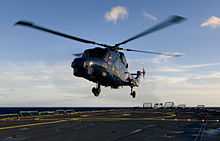



- Lynx Mk.21
- Export version of the HAS.2 for the Brazilian Navy. Brazilian navy designation SAH-11. Nine delivered.[39]
- Super Lynx Mk.21A
- Version of the Super Lynx (based on HAS.8) for the Brazilian navy, with Gem 42 engines and 360° traverse Seaspray 3000 radar under nose. Nine new build helicopters plus upgrades of remaining five original Mk.21s.[40]
- Lynx Mk.22
- Unbuilt export version for the Egyptian Navy.[39]
- Lynx Mk.23
- Export version of the HAS.2 for the Argentine Navy. Two built. Grounded due to British embargo on spares following Falklands War. Single surviving helicopter later sold to Denmark.[39]
- Lynx Mk.24
- Unbuilt export utility version for the Iraqi army.[25]
- Lynx Mk.25
- Export version of the HAS.2 for the Royal Netherlands Navy. Designated UH-14A in Dutch service. Used for utility and SAR roles.[39] Six built.[41]
- Lynx Mk.26
- Unbuilt export armed version for the Iraqi army.[25]
- Lynx Mk.27
- Export version for the Royal Netherlands Navy with 836 kW (1,120 kW) Gem 4 engines. Equipped for ASW missions with dipping sonar. Designated SH-14B in Dutch service. 10 built.[34]
- Lynx Mk.28
- Export version of the AH.1 for the Qatar Police. Three built.[25]
- Lynx Mk.64
- Export version of the Super Lynx for the South African Air Force.
- Lynx Mk.80
- Export version for the Royal Danish Navy based on the HAS.3 but with non-folding tail. Eight built.[42]
- Lynx Mk.81
- Upgraded ASW version for the Royal Netherlands Navy, powered by Gem 41 engines with no sonar but fitted with towed Magnetic anomaly detector. Designated SH-14C in Dutch service, and mainly used for training and utility purposes. Eight built.[43]
- SH-14D
- UH-14A/SH-14B/SH-14C Lynx upgraded to a common standard by the Royal Netherlands Navy under the STAMOL programme with Gem 42 engines, provision for dipping sonar and FLIR. 22 upgraded.[43][44]
- Lynx Mk.82
- Unbuilt export version for the Egyptian army.[25]
- Lynx Mk.83
- Unbuilt export version for the Saudi Arabian army.[25]
- Lynx Mk 84
- Unbuilt export version for the Qatar army.[25]
- Lynx Mk 85
- Unbuilt export version for the United Arab Emirates army.[25]
- Lynx Mk.86
- Export SAR version of the HAS.2 for the Royal Norwegian Air Force.[34]
- Lynx Mk.87
- Embargoed export version for the Argentine navy. Two completed and sold to Denmark as Mk.90[43][45] other six not built[46]
- Lynx Mk.88
- Export version for the German Navy with Gem 42 engines, and dipping sonar. Nineteen built.[47] Super Lynx Mk.88A is an upgraded version with Gem 42 engines, under-nose radome with 360° traverse radar and FLIR above nose. Seven new build helicopters plus conversion of Mk.88s.[48][49]
- Lynx Mk.89
- Export version of HAS.3 for the Nigerian navy. Three built.[47]
- Lynx Mk.90
- Export version for the Royal Danish Navy, modified from embargoed Argentine Mk.87s. Lynx Mk.90A is the upgraded version.[47] The Lynx Mk.90 and Mk.90A were upgraded to Super Lynx standard and designated Mk.90B.[48][49]
- Lynx Mk.95
- Version of Super Lynx for the Portuguese Navy, with Bendix radar in undernose radome, dipping sonar but no FLIR. Three new build plus two converted ex-Royal Navy HAS.3s.[48]
- Super Lynx Mk.99
- Version of Super Lynx for the South Korean Navy, with Seaspray 3 radar in undernose radome, dipping sonar, and FLIR, for anti-submarine and anti-ship operations.[50] Twelve were built. Super Lynx Mk.99A is the upgraded version with improved rotor, with a further 13 built.[51][52] Hulls were produced in the United Kingdom while South Korea supplied domestic ISTAR, electro-optical, electronic warfare, and fire-control systems,[53][54][55] as well as flight control actuators[56] and undercarriage.[57]
- Super Lynx Mk.100
- Super Lynx for the Royal Malaysian Navy, with 990 kW (1,327 hp) CTS-800-4N engines.[58] Six built.[59]
- Super Lynx Mk.110
- Super Lynx 300 for Thai Navy. Four ordered.[59][60]
- Super Lynx Mk.120
- Export version for the Royal Air Force of Oman. 16 built.[59]
- Super Lynx Mk.130
- Export version for the Algerian Navy. Four ordered.[61]
- Super Lynx 300
- Advanced Super Lynx with CTS-800-4N engines.[58]
Projects
- Lynx HT.3
- Proposed training version for the Royal Air Force, not built.
- Lynx-3
- Enhanced Lynx variant with Westland 30 tail boom and rotor, Gem 60 engines, new wheeled tricycle undercarriage and MIL-STD-1553 databus. Only one prototype built (serial/registration ZE477 / G-17-24) in 1984.[62]
- Battlefield Lynx
- Proposed export version of Lynx AH.9.
- Battlefield Lynx 800
- Proposed export version of Lynx AH.9 with LHTEC T800 engines,[63] the project was suspended in 1992.[64] One demonstrator helicopter was built and flight tested.[65]
- Lynx ACH
- Proposed Advanced Compound Helicopter technology demonstrator, partly funded by the Ministry of Defence. Announced in May 1998, the ACH was planned to be powered by RTM322 engines with variable area exhaust nozzles and a gearbox from the Westland 30-200, have wings attached at cabin roof level and BERP rotor blades. It was predicted to fly approximately 50% faster than a standard Lynx.[66]
Derivatives
- Westland 30
- medium helicopter based on the Lynx, using some dynamic systems with a new, enlarged fuselage for up to 22 passengers.
- AgustaWestland AW159 Wildcat
- a development of the Super Lynx with two LHTEC CTS800 engines; previously known as the Future Lynx.
NOTES: AH = Army Helicopter, HAS = Helicopter, Anti-Submarine, HMA = Helicopter, Maritime Attack, IFF = Identification Friend or Foe, (GM) = Gulf Modification, (S) = Secure speech radio, and SIFF = Successor to IFF.
Operators



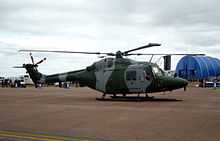
Military operators
Former operators
Specifications (Super Lynx Series 100)
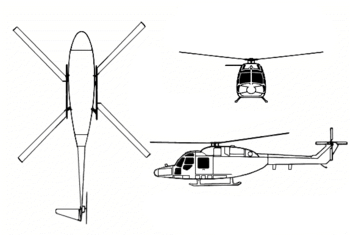
Data from Flight International World Aircraft and Systems Directory (3rd ed.)
General characteristics
- Crew: 2 or 3
- Capacity: 8 troops
- Payload: 1,480 kg [72] (Brochure)
- Length: 15.241 m (50 ft)
- Rotor diameter: 12.80 m (42 ft)
- Height: 3.734 m for mk7; 3.785 m for mk9 (12.25 ft for mk7; 12.41 ft for mk9)
- Disc area: 128.71 m² (1,385 ft²)
- Empty weight: 3,291 kg (7,255 lb)
- Max. takeoff weight: 5,330 kg (11,750 lb)
- Powerplant: 2 × Rolls-Royce Gem turboshaft, 835 kW (1,120 shp) each
Performance
- Maximum speed: 324 km/h (201 mph)
- Range: 528 km (328 miles)with standard tanks
- Naval: 2 x torpedoes or 4x Sea Skua missiles or 2 x depth charges.
- Attack: 2 x 20mm cannons, 2 x 70mm rocket pods CRV7, 8 x TOW ATGM[73]
- General: 7.62mm General Purpose Machine Guns (AH.7 and AH.9), Browning AN/M3M .50 calibre heavy machine gun (HAS.3 and HMA.8)
See also

- Related development
- Aircraft of comparable role, configuration and era
- Bell UH-1N Twin Huey
- Kaman SH-2 Seasprite
- Sikorsky SH-60 Seahawk
- Sikorsky UH-60 Blackhawk
- Related lists
- List of active United Kingdom military aircraft
- List of aircraft of the Army Air Corps
- List of utility helicopters
References
- Notes
- ↑ 1.0 1.1 1.2 Rotorcraft World Records. Fédération Aéronautique Internationale (FAI). Note search under E-1 Helicopters and "Speed over a straight 15/25 km course".
- ↑ James 1991, pp. 400–401.
- ↑ 3.0 3.1 James 1991, p. 401.
- ↑ 4.0 4.1 4.2 Donald, David, ed. "Westland Lynx". The Complete Encyclopedia of World Aircraft. Barnes & Nobel Books, 1997. ISBN 0-7607-0592-5.
- ↑ 5.0 5.1 5.2 Apostolo, Giorgio. "Westland Lynx". "Westland Lynx 3". The Illustrated Encyclopedia of Helicopters. New York: Bonanza Books. 1984. ISBN 978-0-517-43935-7.
- ↑ "AgustaWestland Lynx,Super Lynx and Future Lynx" Jane's Helicopter Markets and Systems. Jane's Information Group, 2010. (subscription article, dated 13 April 2010).
- ↑ James 1991, p. 402.
- ↑ Rotorcraft World Records, List of records established by the 'Lynx A.H. Mk.1'. Fédération Aéronautique Internationale (FAI). Retrieved 15 February 2009.
- ↑ 9.0 9.1 9.2 9.3 9.4 9.5 9.6 9.7 9.8 9.9 9.10 Lynx. Vectorsite.net, 1 January 2010.
- ↑ "Lynx – The World's Fastest Helicopter 20 Years On". SBAC. 2006-08-11. Retrieved 2009-04-30.
- ↑ "Westland Lynx AH.Mk1, G-LYNX/ZB500". Friends of The Helicopter Museum. Retrieved 2009-04-30.
- ↑ 12.0 12.1 Eden 2004, pp. 495, 497.
- ↑ "AgustaWestland Lynx,Super Lynx and Future Lynx". Jane's Helicopter Markets and Systems. Jane's Information group, 2009. subscription article, dated 8 July 2009.
- ↑ Rotorhead images. b-domke.de/AviationImages
- ↑ Ethell and Price 1983, pp. 248–249.
- ↑ "Lynx Helicopter Base Details". Stroicar.com. Retrieved 2013-03-24.
- ↑ "Nederlandse militairen gegijzeld in Libië". De Telegraaf. 3 March 2011. Retrieved 3 March 2011.
- ↑ Lake 1999, pp. 134–135.
- ↑ James 1991, p. 426.
- ↑ James 1991, pp. 405–406.
- ↑ Lake 1999, p. 136.
- ↑ Lake 1999, pp. 135–136.
- ↑ 23.0 23.1 Lake 1999, p. 135.
- ↑ James 1991, p. 411.
- ↑ 25.0 25.1 25.2 25.3 25.4 25.5 25.6 25.7 25.8 Lake 1999, p. 137.
- ↑ Lake 1999, p. 138.
- ↑ "847 Naval Air Squadron". Royal Navy. Retrieved 2013-03-24.
- ↑ Lake 1999, p. 139.
- ↑ Hoyle, Craig (2009-04-30). "British Army's re-engined Lynx AH9A to fly in July". Flight International. Retrieved 2009-07-23.
- ↑ "Upgraded Army Lynx helicopter fleet complete – Announcements – Inside Government – GOV.UK". Mod.uk. 2011-12-16. Retrieved 2013-03-24.
- ↑ Lake 2000, pp. 112–113.
- ↑ James 1991, p. 408.
- ↑ James 1991, p. 418.
- ↑ 34.0 34.1 34.2 Lake 2000, p.114.
- ↑ James 1991, p. 410.
- ↑ 36.0 36.1 Lake 2000 pp. 114–115.
- ↑ 37.0 37.1 37.2 Lake 2000, p. 115.
- ↑ Lake 2000, pp. 118–119.
- ↑ 39.0 39.1 39.2 39.3 Lake 2000 p. 113.
- ↑ Lake 2000, p. 119.
- ↑ Jackson 2003, p. 496.
- ↑ James 1991, p.421.
- ↑ 43.0 43.1 43.2 Lake 2000, p. 116.
- ↑ Laranjeira, Luis. "Versions History". the-grey-lynx.com. Retrieved 2009-04-01.
- ↑ "249,256". Ukserials.com. Retrieved 2013-03-24.
- ↑ "264,281,282,284,287,289". Ukserials.com. Retrieved 2013-03-24.
- ↑ 47.0 47.1 47.2 Lake 2000 p.117.
- ↑ 48.0 48.1 48.2 Lake 2000, p. 120.
- ↑ 49.0 49.1 Naval Lynx HAS.3 / HAS.3 Export Variants. Vectorsite.net, 1 January 2010.
- ↑ "Super Lynx ASW exercise".
- ↑ Lake 2000, p. 121.
- ↑ Naval Lynxes / Next-Generation Lynxes & Derivatives. Vectorsite.net, 1 January 2010.
- ↑ "LIG Nex1 Super Lynx ISR/EW".
- ↑ "Samsung Thales Super Lynx electro-optical targeting system".
- ↑ "Samsung Thales Super Lynx dipping sonar".
- ↑ "Hanwha Super Lynx flight control actuator".
- ↑ "WIA Super Lynx undercarriage".
- ↑ 58.0 58.1 Gray Flight International 16–22 July 2002, p. 90.
- ↑ 59.0 59.1 59.2 Penney. Flight International. 16–22 July 2002, p.92.
- ↑ Flight International. 11–17 November 2008, p. 73.
- ↑ Flight International. 11–17 November 2008, p. 52.
- ↑ "Lynx family gets tougher". Flight International: 596. 1983-03-05.
- ↑ Flight International 30 January-5 February 1991, p.16.
- ↑ Flight International, 11–17 March 1992.
- ↑ Eden 2004, p. 497.
- ↑ Warwick, Graham (1998-05-27). "Westland prepares compound helicopter demonstrator". Flight International.
- ↑ 67.0 67.1 67.2 67.3 67.4 67.5 67.6 67.7 67.8 67.9 67.10 67.11 67.12 67.13 "World Air Forces 2013". Flightglobal Insight. 2013. Retrieved 10 March 2013.
- ↑ "Comando de Aviacion Naval Argentina Lynx". Retrieved 10 March 2013.
- ↑ "Maritieme helikopter Lynx zwaait af (video) | Ministerie van Defensie". Defensie.nl. 2012-09-11. Retrieved 2013-03-24.
- ↑ "World's Air Forces 2001 Pg. 62". flightglobal.com. Retrieved 10 March 2013.
- ↑ "Pakistan naval air arm Lynx". Retrieved 10 March 2013.
- ↑ "AW159". AgustaWestland. Retrieved 2013-03-24.
- ↑ army.mod.uk: Lynx AH7 & AH9
- Bibliography
- Eden, Paul, ed. "Westland Lynx".Encyclopedia of Modern Military Aircraft. Amber Books, 2004. ISBN 1-904687-84-9.
- Ethell, Jeffrey and Price, Alfred. Air War South Atlantic. London:Sidgwick and Jackson, 1983. ISBN 0-283-99035-X.
- Gray, Peter. "New Life For Lynx". Flight International, 16–22 July 2002. pp. 84–90.
- James, Derek N. Westland Aircraft since 1915. London: Putnam, 1991, ISBN 0-85177-847-X.
- Jackson, Paul. Jane's All The World's Aircraft 2003–2004. Coulsdon, UK, 2003. ISBN 0-7106-2537-5.
- Lake, Jon. "Westland Lynx Variant Briefing:Part 1". World Air Power Journal, Volume 39, Winter 1999. London: Aerospace Publishing. ISBN 1-86184-039-X. ISSN 0959-7050. pp. 126–141.
- Lake, Jon. "Westland Lynx Variant Briefing:Part 2". World Air Power Journal, Volume 40, Spring 2000. London: Aerospace Publishing. ISBN 1-86184-043-X . ISSN 0959-7050. pp. 112–121.
- Penny, Stewart. "Fitter Feline". Flight International, 16–22 July 2002. pp. 92–95.
- "T800-engined Lynx set for Paris debut". Flight International, 30 January – 5 February 1991. p. 16.
- "T800 LYNX PROGRAMME STALLS". Flight International, 11–17 March 1992, p. 18.
- "Directory:World Air Forces". Flight International, 11–17 November 2008, pp. 52–76.
External links
| Wikimedia Commons has media related to Westland Lynx. |
- Super Lynx 300 page on AgustaWestland.com
- The Westland Scout, Wasp, & Lynx page on vectorsite.net
- Lynx Mk 7/ Mk 9 Multi-Role Helicopter page on Army-technology.com
- Westland Lynx section on helis.com
- Westland Lynx page on militaryfactory.com
- Fédération Aéronautique Internationale (FAI) rotorcraft world records page
- "Westland-Aerospatiale Lynx" a 1974 Flight article
| |||||||||||||||||
| |||||||||||||||||
| ||||||||||||||